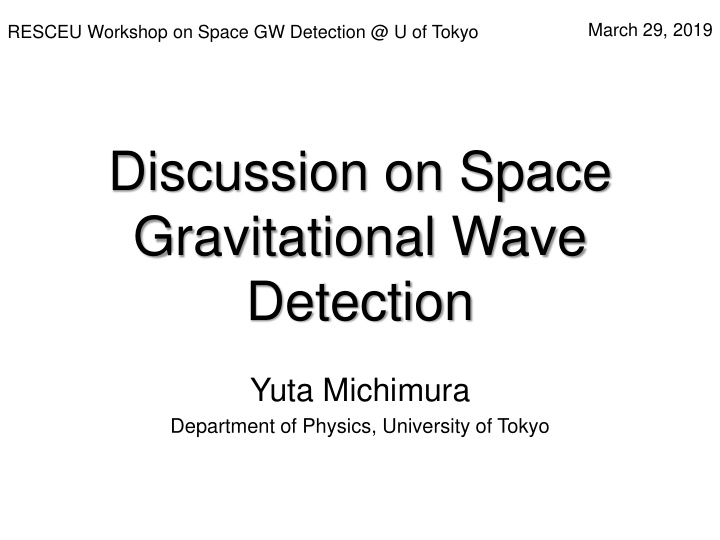



March 29, 2019 RESCEU Workshop on Space GW Detection @ U of Tokyo Discussion on Space Gravitational Wave Detection Yuta Michimura Department of Physics, University of Tokyo
Questions • How to realize DECIGO-like sensitivity? - Possibility in Japan? (vs KAGRA?) - FP-type TianQin? - Any new ideas? - Do we really need DECIGO? Descope? - LiteBIRD is enough? • Any pathfinders? Space demonstrations? - Science case for intermediate steps? • International collaboration? - Fabrication, test, launch • How to attract students? - How to increase the number of people? 2
Space GW Detectors LISA TianQin B-DECIGO Arm length 2.5e6 km 1.7e5 km 100 km Interferometry Optical Optical Fabry-Pérot transponder transponder cavity Laser frequency Reference cavity, Reference cavity, Iodine, 515 nm stabilization 1064 nm 1064 nm Orbit Heliocentric Geocentric, facing Geocentric (TBD) J0806.3+1527 Flight Constellation Constellation Formation flight configuration flight flight Test mass 1.96 kg 2.45 kg 30 kg Acceleration 1e-15 N/rtHz 7e-15 N/rtHz 1e-16 N/rtHz noise 3
Sensitivity Curves http://gwplotter.com/ 4
Horizon Distance B-DECIGO CE LISA B-DECIGO*10 ET z=10 TianQin aLIGO B-DECIGO*100 z=1 GW150914 5 Optimal direction and polarization SNR threshold 8
Sensitivity Design NOTE that they are not official sensitivity curves! LISA B-DECIGO KAGRA DECIGO 6
Observation Scenario (Ground) iKAGRA (room temp.) O3 bKAGRA Phase 1 Upgrade (cryogenic) Living Reviews in Relativity 21, 3 (2018); updated version available from 7 https://git.ligo.org/publications/detectors/obs-scenarios-2018/blob/master/Figures/ObsScen_fig2_v12.pdf
Roadmap (Ground and Space) https://www.dropbox.com/s/wxe1taqa1nsw1oi/spaceGW181113_ando.pdf 8
Recommend
More recommend